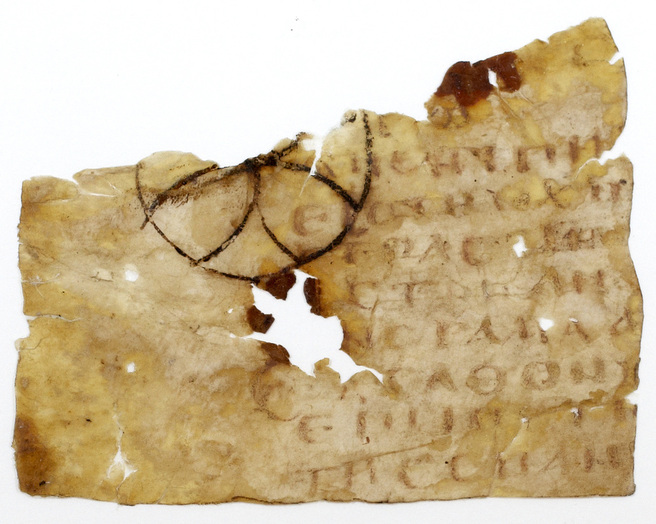P.Monts. Roca 4.50 (LDAB 2863) is a fifth-century Greek New Testament manuscript fragment housed in the Montserrat Abbey in Spain, where it is kept under the inventory no. 16 (the online Kurzgefasste Liste incorrectly gives the former shelf number, P.Barc. 16). It contains portions of Luke 8:25-27 and is listed in the official list of New Testament manuscripts as GA 0267. It was originally edited by Ramon Roca-Puig in 1963, but a new edition has just appeared in Sofía Torallas Tovar and Klaas A. Worp, ed., with the collaboration of Alberto Nodar and María Victoria Spottorno, Greek Papyri from Montserrat (P.Monts. Roca IV) (Barcelona: 2014), no. 50. Here is a recent, high-resolution image, available online at the DVCTVS digital catalogue:
There are some odd features of this little parchment fragment. First, there is a mysterious drawing of a circle with arcs connected at a central point that no one has been able to explain satisfactorily. One guess (made by Roca-Puig) is that it may be a scholar's geometrical draft. Whatever this drawing may be, it was clearly drawn after the biblical text had been written. Second, the back is completely blank. The recent edition suggests that the text may have been washed away. But if this is the case, then for what purpose? Usually text was erased from a parchment so that it could be reused (i.e., made into a palimpsest), but in this case, there is no text at all. Third, the text is registered in the official list of New Testament manuscripts, even though there is obviously a question mark as to whether this text was in fact "continuous." For a Greek manuscript to be given a Gregory-Aland number and catalogued in the official list of New Testament manuscripts, it must be a continuous manuscript, that is, a manuscript containing an entire New Testament book from beginning to end. The traditional way of verifying whether a manuscript was continuous or not is textual continuity. In other words, if the text continues sequentially from one side of the page onto the other side, then it is a continuous manuscript. The criterion of textual continuity must be applied with caution, however, in light of the limitations of smaller, fragmentary manuscripts. A non-continuous text—such as an amulet, inscription, ostracon, private letter, etc.—cannot, as a rule, be registered as an official manuscript of the New Testament, even if the artifact contains a significant citation. In any case, this fragment was apparently assumed to be continuous, even though that fact cannot be proven.
So, lots of questions remain concerning this little Greek fragment. Was this text actually written on one side only? If this is the case, then couldn't the parchment just as well have been produced as an amulet, an isolated sheet for devotional purposes, a citation in some other Christian literary work, etc.? The context (the Garasene demoniac) may suggest that it was in fact an amulet. I suppose the professional script and generous margin (and possible binding holes in the margin) point in the opposite direction, suggesting a well-made codex. Perhaps an alternative explanation is that it was cut out of a codex and re-used as an amulet, for which there are several examples. And what should we make of the circular drawing? A geometrical draft? A doodle? A "magic" sign? Whatever the case, the scribe apparently had little regard for the biblical text, since he/she drew the circle over it. Anyway, this little fragment has been given very little attention in scholarship, but I think it interesting for the reasons listed above and deserves further study.
So, lots of questions remain concerning this little Greek fragment. Was this text actually written on one side only? If this is the case, then couldn't the parchment just as well have been produced as an amulet, an isolated sheet for devotional purposes, a citation in some other Christian literary work, etc.? The context (the Garasene demoniac) may suggest that it was in fact an amulet. I suppose the professional script and generous margin (and possible binding holes in the margin) point in the opposite direction, suggesting a well-made codex. Perhaps an alternative explanation is that it was cut out of a codex and re-used as an amulet, for which there are several examples. And what should we make of the circular drawing? A geometrical draft? A doodle? A "magic" sign? Whatever the case, the scribe apparently had little regard for the biblical text, since he/she drew the circle over it. Anyway, this little fragment has been given very little attention in scholarship, but I think it interesting for the reasons listed above and deserves further study.

